April 23rd is traditionally given as Shakespeare’s birthday, even though the only hard date we have is his christening (he was baptized in the Church of the Holy Trinity, in Stratford, on Wednesday 26 April 1564). In honor of this, we purchased an odd little edition of one of Shakespeare’s sources.
 Le theatre du monde, ou il est fait un ample discours des miseres humaines. … Avec un petit traite d le’excellence & dignite de l’homme. Paris: Jacques Stoer, 1607. According to the bookseller, “A rare edition of this anthology of human misfortune. The description of a 1546 plague outbreak at Aix that appears on pages 122-24 was taken from the account of Nostradamus’ treatise on cosmetics and preserves. The first edition appeared in Paris in 1558. The “Brief discours de l’excellence & dignité de l’homme” has a separate title-page and begins on page 185.”
Le theatre du monde, ou il est fait un ample discours des miseres humaines. … Avec un petit traite d le’excellence & dignite de l’homme. Paris: Jacques Stoer, 1607. According to the bookseller, “A rare edition of this anthology of human misfortune. The description of a 1546 plague outbreak at Aix that appears on pages 122-24 was taken from the account of Nostradamus’ treatise on cosmetics and preserves. The first edition appeared in Paris in 1558. The “Brief discours de l’excellence & dignité de l’homme” has a separate title-page and begins on page 185.”
We acquired this work by Pierre Boaistuau, known as Pierre Launay (1500-1566) from a rare book dealer in Worcester, MA. “Boaistuau was a French author, editor, translator. He was the first editor of the works of Marguerite de Navarre. The present work was his greatest success as an author and went through a number of editions and translations.”
Shakespeare used this work for his Timon of Athens, which is “a play of strange clamour and majesty, ” according to Peter Ackroyd in a recent biography. “It is the story of a man whose lavish generosity is not reciprocated and who, as a result, falls into a state of savage misanthropy.” In other words, very much a play for our times.

Comments Off on In honor of the Bard’s birthday–this just in!
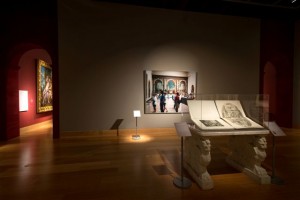 We are happy to welcome back our copy of Valentin Lefebvre’s Opera Selectiora (Venice, 1682), which we loaned to the John and Mable Ringling Museum of Art in Sarasota, for an exhibition on Paolo Veronese. Shown here is a shot of the book in their gallery.
We are happy to welcome back our copy of Valentin Lefebvre’s Opera Selectiora (Venice, 1682), which we loaned to the John and Mable Ringling Museum of Art in Sarasota, for an exhibition on Paolo Veronese. Shown here is a shot of the book in their gallery.
The museum published a lavish catalog, a copy of which we received for contributing to the show.
Comments Off on Welcome back!
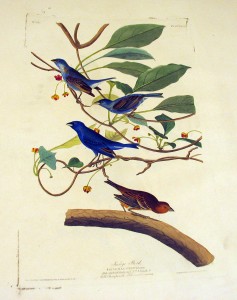 “The Indigo Bird arrives in the Southern States from the direction of Mexico, along with its relative the Painted Finch, and is caught in trap-cages, but with more difficulty than the latter bird. It spreads far and wide over the United States, extending from the borders of our Atlantic shores to those of our great lakes. It is not a forest bird, but prefers the skirts of the woods, the little detached thickets in and along the fields, the meadows, the gardens, and orchards, and is frequently seen hopping along, or perched on a fence, from which is does not disdain to send forth its pretty little song . . .
“The Indigo Bird arrives in the Southern States from the direction of Mexico, along with its relative the Painted Finch, and is caught in trap-cages, but with more difficulty than the latter bird. It spreads far and wide over the United States, extending from the borders of our Atlantic shores to those of our great lakes. It is not a forest bird, but prefers the skirts of the woods, the little detached thickets in and along the fields, the meadows, the gardens, and orchards, and is frequently seen hopping along, or perched on a fence, from which is does not disdain to send forth its pretty little song . . .
I have represented an adult female, two young males of the first and second year, in autumn, and a male in the full beauty of its plumage. They are placed on a plant usually called the Wild Sarsparilla.”
–J. J. Audubon, Ornithological Biography, I (1831), 377-379 [excerpted].
Comments Off on The Indigo Bird (Audubon “bird of the week”)

Yesterday we formally opened the exhibition on “Hyam Plutzik ’32, American Poet,” featuring a reading of selected poems by Plutzik by Ciaran Berry (Assistant Professor of English), Clare Rossini (Artist-in-Residence), Dick Allen (Connecticut’s Poet Laureate), and Trinity students Diana Lestz ’13 and Cassie Spittel ’13. All of the readers also read one of their own poems in Plutzik’s honor.
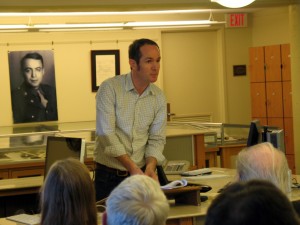 The exhibition was curated by Ed Moran, literary adviser to the Plutzik family, and most of the material was generously lent by the University of Rochester, although some artifacts (like Plutzik’s fishing gear) were lent by the family.
The exhibition was curated by Ed Moran, literary adviser to the Plutzik family, and most of the material was generously lent by the University of Rochester, although some artifacts (like Plutzik’s fishing gear) were lent by the family.
Associate Curator Sally Dickinson and staffer Henry Arneth were instrumental in the installation of the exhibit, which will be on display through the end of May, so that those who come to campus for Commencement will be able to view a slice of the life and work of this accomplished Trinity alum who died well before his time

Comments Off on Past and Present Poetic Voices
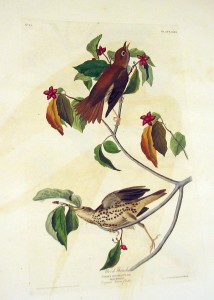 “Kind reader, you now see before you my greatest favourite of the feathered tribes of our woods. To it I owe much. How often has it revived my drooping spirits, when I have listened to its wild notes in the forest, after passing a restless night in my slender shed, so feebly secured against the violence of the storm, as to shew me the futility of my best efforts to rekindle my little fire, whose uncertain and vacillating light had gradually died away under the destructive weight of the dense torrents of rain that seemed to involve the heavens and the earth in one mass of fearful murkiness, save when the red streaks of the flashing thunderbolt burst on the dazzled eye, and, glancing along the huge trunk of the stateliest and noblest tree in my immediate neighbourhood, were instantly followed by an uproar of crackling, crashing, and deafening sounds, rolling their volumes in tumultuous eddies far and near, as if to silence the very breathings of the unformed thought!”
“Kind reader, you now see before you my greatest favourite of the feathered tribes of our woods. To it I owe much. How often has it revived my drooping spirits, when I have listened to its wild notes in the forest, after passing a restless night in my slender shed, so feebly secured against the violence of the storm, as to shew me the futility of my best efforts to rekindle my little fire, whose uncertain and vacillating light had gradually died away under the destructive weight of the dense torrents of rain that seemed to involve the heavens and the earth in one mass of fearful murkiness, save when the red streaks of the flashing thunderbolt burst on the dazzled eye, and, glancing along the huge trunk of the stateliest and noblest tree in my immediate neighbourhood, were instantly followed by an uproar of crackling, crashing, and deafening sounds, rolling their volumes in tumultuous eddies far and near, as if to silence the very breathings of the unformed thought!”
–J. J. Audubon, Ornithological Biography, I (1831), 372 [excerpted].
Comments Off on The Wood Thrush (Audubon “bird of the week”)
 “They always feed on the wing. In calm and warm weather, they soar to an immense height, pursuing the large insects called Musquito Hawks, and performing the most singular evolutions that can be conceived, using their tail with an elegance of motion peculiar to themselves. Their principal food, however, is large grasshoppers, grass-caterpillars, small snakes, lizards, and frogs. They sweep close over the fields, sometimes seeming to alight for a moment to secure a snake, and holding it fast by the neck, carry it off, and devour it in the air. When searching for grasshoppers and caterpillars, it is not difficult to approach them under cover of a fence or tree. When one is then killed and falls to the ground, the whole flock comes over the dead bird, as if intent upon carrying it off. An excellent opportunity is thus afforded of shooting as many as may be wanted, and I have killed several of these Hawks in this manner, firing as fast as I could load my gun.”
“They always feed on the wing. In calm and warm weather, they soar to an immense height, pursuing the large insects called Musquito Hawks, and performing the most singular evolutions that can be conceived, using their tail with an elegance of motion peculiar to themselves. Their principal food, however, is large grasshoppers, grass-caterpillars, small snakes, lizards, and frogs. They sweep close over the fields, sometimes seeming to alight for a moment to secure a snake, and holding it fast by the neck, carry it off, and devour it in the air. When searching for grasshoppers and caterpillars, it is not difficult to approach them under cover of a fence or tree. When one is then killed and falls to the ground, the whole flock comes over the dead bird, as if intent upon carrying it off. An excellent opportunity is thus afforded of shooting as many as may be wanted, and I have killed several of these Hawks in this manner, firing as fast as I could load my gun.”
–J. J. Audubon, Ornithological Biography, I (1831), 369 [excerpted].
Comments Off on The Swallow-tailed Hawk (Audubon “bird of the week”)
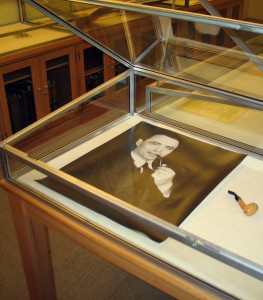 Our April/May exhibition will focus on the life and career of Trinity alumnus Hyam Plutzik ’32, who studied under Trinity professor Odell Shepard (1884-1967). During his student years, Plutzik served as an editor on the Tripod, and helped revive the student yearbook, the Trinity Tablet, which had been dormant for many years. Several years after graduation, he returned to Connecticut to spend a “Thoreauvian” year in the countryside, undoubtedly inspired by Professor Shepard’s interest in the nineteenth-century Transcendentalists. In 1941, on the eve of America’s entry into World War II, Plutzik wrote a detailed account of his life since graduation in a remarkable 72-page letter to Odell Shepard, the original of which is in the Watkinson, and will be on display. It was Odell Shepard who wrote Plutzik’s recommendation letter to Yale University, where he pursued graduate work on scholarship from Trinity College
Our April/May exhibition will focus on the life and career of Trinity alumnus Hyam Plutzik ’32, who studied under Trinity professor Odell Shepard (1884-1967). During his student years, Plutzik served as an editor on the Tripod, and helped revive the student yearbook, the Trinity Tablet, which had been dormant for many years. Several years after graduation, he returned to Connecticut to spend a “Thoreauvian” year in the countryside, undoubtedly inspired by Professor Shepard’s interest in the nineteenth-century Transcendentalists. In 1941, on the eve of America’s entry into World War II, Plutzik wrote a detailed account of his life since graduation in a remarkable 72-page letter to Odell Shepard, the original of which is in the Watkinson, and will be on display. It was Odell Shepard who wrote Plutzik’s recommendation letter to Yale University, where he pursued graduate work on scholarship from Trinity College
Most of the materials on display are on loan from the University of Rochester, which hosts the Plutzik Reading Series, one of the longest-running reading series in the country.
 The opening of the exhibition (which is being installed as I write) will be on April 9, from 1:30 – 3:30pm, and will feature readings of Plutzik’s work by our own award-winning poet Ciaran Berry, Artist-in-Residence Clare Rossini, and Dick Allen, the Poet Laureate of Connecticut. Trinity students will also read selections of their own poetry.
The opening of the exhibition (which is being installed as I write) will be on April 9, from 1:30 – 3:30pm, and will feature readings of Plutzik’s work by our own award-winning poet Ciaran Berry, Artist-in-Residence Clare Rossini, and Dick Allen, the Poet Laureate of Connecticut. Trinity students will also read selections of their own poetry.
Comments Off on Hyam Plutzik ’32, American Poet
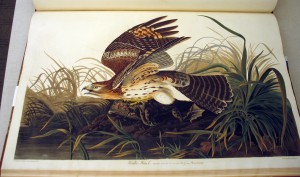 “Every species of bird is possessed of a certain, not always definable, cast of countenance, peculiar to itself. Although it undergoes changes necessary for marking the passions of the individual, its joy, its anger, its terror or despondency, still it remains the same specific look. Hawks are perhaps more characteristically marked in this manner than birds of any other genus, being by nature intended for deeds of daring enterprise, and requiring a greater perfection of sight to enable them to distinguish their prey at great distances. To most persons the family-look of particular species does not appear so striking as to the student of nature, who examines her productions in the haunts which she has allotted to them. He perceives at a glance the differences of species, and when he has once bent his attention to an object, can distinguish it at distances which to the ordinary observer present merely a moving object, whether beast or bird. When years of constant observation have elapsed, it becomes a pleasure to him to establish the differences that he has found to exist among the various species of a tribe, and to display to others whose opportunities have been more limited the fruits of his research.”
“Every species of bird is possessed of a certain, not always definable, cast of countenance, peculiar to itself. Although it undergoes changes necessary for marking the passions of the individual, its joy, its anger, its terror or despondency, still it remains the same specific look. Hawks are perhaps more characteristically marked in this manner than birds of any other genus, being by nature intended for deeds of daring enterprise, and requiring a greater perfection of sight to enable them to distinguish their prey at great distances. To most persons the family-look of particular species does not appear so striking as to the student of nature, who examines her productions in the haunts which she has allotted to them. He perceives at a glance the differences of species, and when he has once bent his attention to an object, can distinguish it at distances which to the ordinary observer present merely a moving object, whether beast or bird. When years of constant observation have elapsed, it becomes a pleasure to him to establish the differences that he has found to exist among the various species of a tribe, and to display to others whose opportunities have been more limited the fruits of his research.”
–J. J. Audubon, Ornithological Biography, I (1831), 364 [excerpted].
Comments Off on The Winter Hawk (Audubon “bird of the week”)
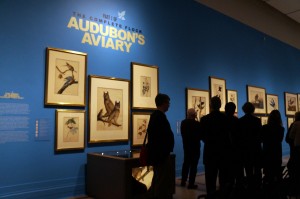 I was thrilled to be invited by the Alumni Office to speak about the Watkinson’s collections related to natural history at an alumni event in New York. The New York Historical Society has mounted the first of three exhibitions of Audubon’s original paintings, most of which were used as the basis for producing the 435 aquatint engravings for his famous Birds of America (completed in 1838).
I was thrilled to be invited by the Alumni Office to speak about the Watkinson’s collections related to natural history at an alumni event in New York. The New York Historical Society has mounted the first of three exhibitions of Audubon’s original paintings, most of which were used as the basis for producing the 435 aquatint engravings for his famous Birds of America (completed in 1838).
Over 40 alumni of Trinity College came out last week on a crisp evening to take a tour of the four large galleries which hold over 160 pieces of art, manuscript letters, and various small artifacts which comprise “Part I” of the exhibition. You can hear the recent NPR story on Audubon, which mentions the exhibition.
 Also joining us was professor Tom Wickman, who has structured a history course around our Enders ornithology collection. We are team-teaching this course in the library, and were delighted that one of our students (and her parents) also made it to the event.
Also joining us was professor Tom Wickman, who has structured a history course around our Enders ornithology collection. We are team-teaching this course in the library, and were delighted that one of our students (and her parents) also made it to the event.
The Society’s docents did an excellent job taking our two groups through the exhibition, explaining in broad strokes the very interesting life that Audubon led, which culminated in the production of his famous (and famously big) book. After the tour, I spoke about our amazing copy of the Birds of America, the plates of which were selected and hand-colored by the engraver himself (Robert Havell, Jr.), and passed from his hands in 1878 to a book firm and then to a Trinity alum, Dr. Gurdon Russell (class of 1834). Dr. Russel owned the set for over 20 years before giving it to Trinity College in 1900, where it has been kept safe and made available to students ans scholars for over a century.
 I concluded my remarks by emphasizing the use to which we put these collections throughout the school year, through presentations, events, and initiatives like our unique Creative Fellowship Program. We all had a great time, and I hope the alums will remember to visit the Watkinson when their classes return to campus for a visit to see the Audubon, which is on permanent display.
I concluded my remarks by emphasizing the use to which we put these collections throughout the school year, through presentations, events, and initiatives like our unique Creative Fellowship Program. We all had a great time, and I hope the alums will remember to visit the Watkinson when their classes return to campus for a visit to see the Audubon, which is on permanent display.
Comments Off on Amazing Audubon Exhibition at NYHS
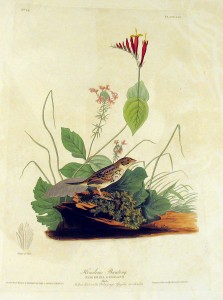 “I obtained the bird represented in this plate opposite Cincinnati, in the State of Kentucky, in the year 1820, whilst in the company of Mr. ROBERT BEST, then Curator of the Western Museum. It was on the ground, amongst tall grass, and exhibited the usual habits of its tribe. Perceiving it to be different from any which I had seen, I immediately shot it, and the same day made an accurate drawing of it.
“I obtained the bird represented in this plate opposite Cincinnati, in the State of Kentucky, in the year 1820, whilst in the company of Mr. ROBERT BEST, then Curator of the Western Museum. It was on the ground, amongst tall grass, and exhibited the usual habits of its tribe. Perceiving it to be different from any which I had seen, I immediately shot it, and the same day made an accurate drawing of it.
In naming it after the Rev. Professor HENSLOW of Cambridge, a gentleman so well known to the scientific world, my object has been to manifest my gratitude for the many kind attentions which he has shewn towards me. Its history and habits are unknown. In appearance it differs so little from the Buntings, that, for the present, I shall refer to that genus.”
–J. J. Audubon, Ornithological Biography, I (1831), 358 [excerpted].
Comments Off on Henslow’s Bunting (Audubon “bird of the week”)
 We are happy to welcome back our copy of Valentin Lefebvre’s Opera Selectiora (Venice, 1682), which we loaned to the John and Mable Ringling Museum of Art in Sarasota, for an exhibition on Paolo Veronese. Shown here is a shot of the book in their gallery.
We are happy to welcome back our copy of Valentin Lefebvre’s Opera Selectiora (Venice, 1682), which we loaned to the John and Mable Ringling Museum of Art in Sarasota, for an exhibition on Paolo Veronese. Shown here is a shot of the book in their gallery.













